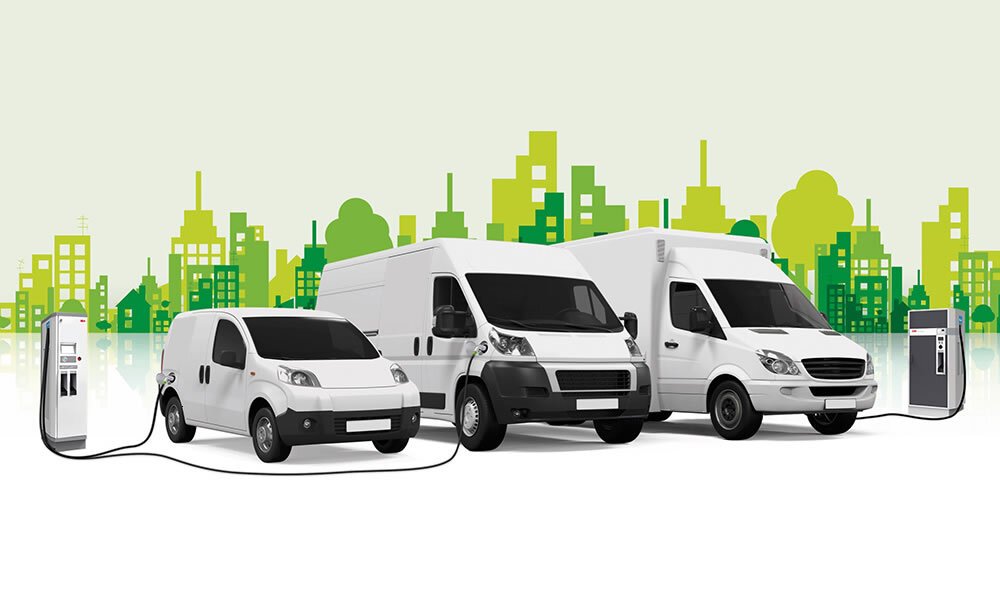The big 5: What to ask when speccing fleet EVs
Right-sizing your electric vehicle options starts with these important asks
Choosing EV for your organization’s fleet has to be all about that—your organization. Answering five foundational questions can help you determine the kind of vehicles you need and the impact they’ll have on your operations, so you can start shopping smart.
Image source: Electriphi (https://www.electriphi.ai/insights/how-to-charge-an-electric-vehicle-fleet)
Even recently, talk about electric vehicles as viable commercial fleet options was exploratory, if not downright theoretical for most businesses. But lots of factors, including gas prices (up, up, up) and sticker prices for EV (ever downward, including cost reductions from government incentives) are accelerating the arrival of EV choices to the market, putting these climate- and budget-friendly vehicles front and center in planning conversations for companies big and small.
Of course, not all commercial EVs are created equal—or equal to the task at hand. Like internal combustion models, electric vehicles come in a variety of shapes and sizes, from the Nikola Two long-haul sleeper with 900 miles of range, to the Workhorse C-Series, a punchy delivery truck ideal for last-mile fulfillment. Analysts PWC have predicted that the latter category—light transportation vehicles—will be the first of the commercial EVs to equal internal combustion truck models in total cost of ownership (TCO), with other model types not far behind.
But the real question (or five) isn’t all about big trends in EV tech. It’s about what works for getting your business done in the Genesee/Finger Lakes region—or wherever your fleet roams.
We liked the way Fleetio lays out the basic areas to think about. You can read their full article here, but when you start narrowing the field of choices, five questions should be top of mind in the 585 (and the 607 and 315!):
1. What kind of range do I need?
Image source: EVAdoption.com (https://evadoption.com/ev-models/bev-models-currently-available-in-the-us/)
Unlike consumer vehicles, most commercial EV ranges are determined by the job the vehicle needs to do. And like we said, you won’t use a long-haul semi to do a door-to-door truck’s work, or vice versa. So ask yourself where your current fleet actually goes. Around Rochester making deliveries? Back and forth from Syracuse to Buffalo? Loaded with heavy cargo from Batavia out of state? Just like any other investment, EV vehicles have to be right-sized for your company.
2. Which battery type is best?
Batteries don’t just equal range. They also typically account for the highest maintenance and repairs costs with EV. Do your research and ask about what you’d have to pay for a replacement. Hydrogen fuel-cell batteries and cutting edge lithium-ion batteries don’t run the same in terms of dollars.
3. Where should we charge up?
On-site. Quick charging. Public options. There’s lots to discover about charging choices and associated costs. This recent piece by Automotive Fleet dives a bit deeper, but again, the EVs you choose (and how they’re driven) will be the guide. Charging will be different for drivers who take their vehicles to a suburban home in Bloomfield vs. a large centralized fleet that parks overnight in a Penn Yan lot.
4. What will maintenance cost?
With no oil changes or air filter replacements, and simply fewer moving parts to break down, maintenance is lower for EVs, and the resulting savings are converting skeptics, even in our backyard. But EV expertise and the right preventive maintenance are critical to make sure these new technologies don’t generate surprise fixes and costs. That starts with making sure your in-house or third-party techs are EV-certified.
5. How about upfitting?
Thinking about the extras your vehicles will need should include thinking about where those upfits will get their power. If it’s from the vehicle batteries, that may factor into range, charging time, and fuel costs. But some new EVs are coming to market with auxiliary power sources for vehicle add-ons, tools, and devices. Check the specs against the gear your teams will need in the field and on the road in WNY.
Understanding the cost of EV mx. Image source: EV Solutions (https://blog.evsolutions.com/how-expensive-is-ev-maintenance)
These five questions are a good basis for beginning to assess an EV future for your fleet. And starting small may be the key for many businesses. A limited integration will keep initial capital outlay lower and give companies like yours time to gather data on employee productivity, fuel use, and the total cost of ownership you’ll see for your EVs.
Resources:
Plug-In Electric Vehicle Handbook for Fleet Managers - This handbook answers your basic questions about plug-in electric vehicles and charging infrastructure and points you to additional information to make fleet decisions.
Learn more about the financial incentives that can help your bottom line when converting to an EV fleet: Drive Clean Rebate and NYS Truck Voucher Incentive Program
Atlas Policy's Fleet Procurement Tool - Not for the feint of heart, this tool is for those who want to go deep on crunching the numbers and visualizing the impacts of adding electric vehicles to your fleet. Even if you’re not an Excel wizard, seeing all the inputs they use in the modeling process can help you think through your own decision. Have you thought about gas price fluctuations over time? Expected years of ownership? Societal benefits of lower fossil fuel emissions? The folks at Atlas Policy have. Check it out!



